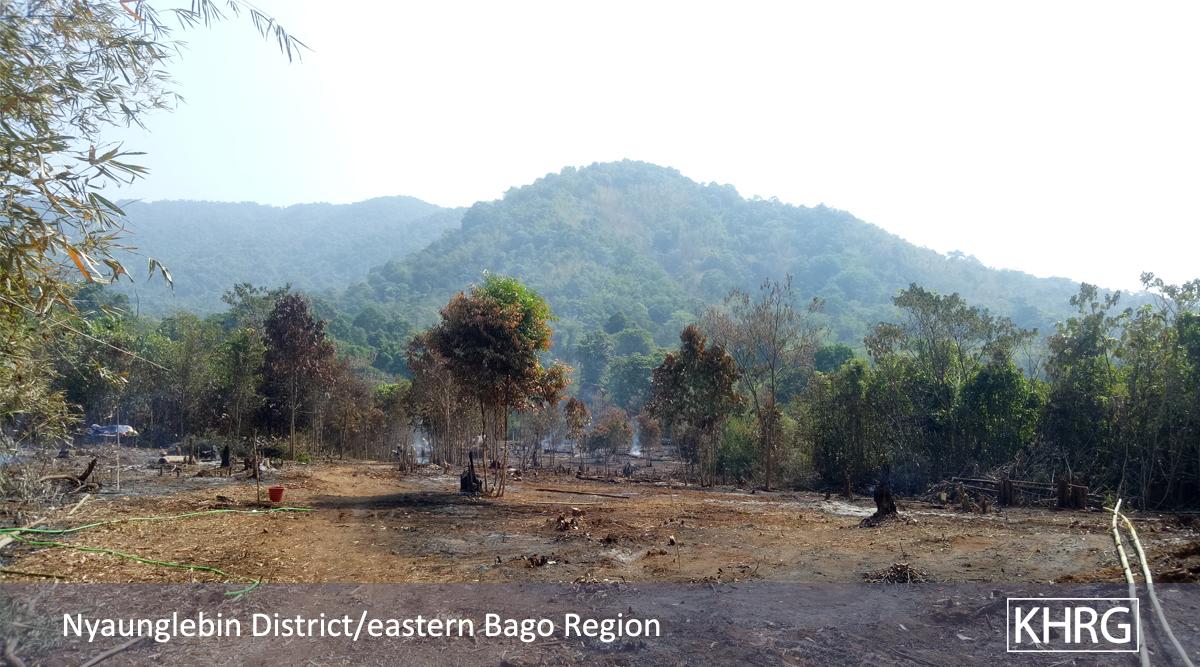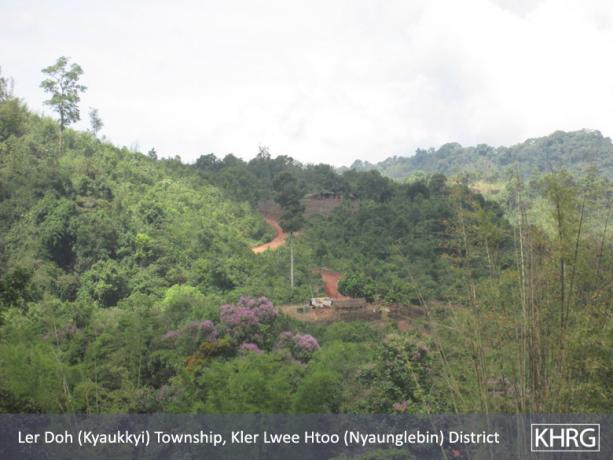This Situation Update describes events occurring in Kyaukkyi Township, Nyaunglebin District in 2014, including Tatmadaw militarisation, villagers’ livelihoods and access to health and education.
- Villagers’ livelihoods in highland and lowland areas in Kyaukkyi Township are described.
- In 2014, the Tatmadaw has begun to increase the amount of rations it is transporting through Kyaukkyi Township, using 60 to 70 trucks per trip, as opposed to 40 to 50 trucks per trip in 2013.
- The Burma/Myanmar government has begun building a new school and clinic in Mu Theh village.
Situation Update | Kyaukkyi Township, Nyaunglebin District (July 2014)
The following Situation Update was received by KHRG in July 2014. It was written by a community member in Nyaunglebin District who has been trained by KHRG to monitor local human rights conditions. It is presented below translated exactly as originally written, save for minor edits for clarity and security.[1] This report was received along with other information from Nyaunglebin District, including one other situation update, 277 photographs and two video clips.[2]
Introduction
This is the situation in Kyaukkyi Township, Nyaunglebin District where there are some difficulties that the villagers have to face. I am going to write about the situation that I know, that I have heard and that I have seen in my township [organised in] the topics below. The main topics are:
1) The situation of the civilians
2) Government military activity
3) Children and education
4) Government activities, such as building schools and clinics
The situation of the civilians
Most of the civilians who live in Kyaukkyi Township, Nyaunglebin District are farmers and hill farmers. Some of them [civilians] live in the mountain [areas] and some of them live in flat field areas [lowlands]. Those who live in the mountain [areas] work on hill fields and cultivate paddy[3] as their main food [source]. They also plant vegetables like mustard, pumpkin, long bean, cucumber, luffa gourd, taro, yam and turmeric. As they grow these vegetables, they do not need to buy vegetables to eat from others. As for the cost of fish paste and salt, they sell fruit, such as dog fruit[4], and cardamom that they grow [in their own fields] during the rainy season and they use that [profit] to buy fish paste and salt. Sometimes, when they are faced with illness, they sell their fruit, buy some of their house cooking ingredients [fish paste and salt] and then they keep some of their money for the cost of medicine. If they feel sick, they use the money that they received from selling their cardamom and dog fruit. In mountain areas, there are only about 30% of villagers who are literate and the rest of the percentage [70%] will be the villagers who are working on cultivation and hill farming.
In the flat areas, the villagers are working on paddy fields for their livelihoods. They cultivate paddy as their main food [source]. After they have finished working for [harvesting] their paddy, they start to plough [their fields] again in order to cultivate their beans, such as groundnut [peanuts], and many other kinds of beans. They cultivate beans [peanuts] and they grind them into oil. They sell the oil in order to [pay to] send their children to school. They use some of the money that they received from selling the oil to send their children to school and some of the money to buy cooking ingredients for their home, such as fish pate and salt. In this flat area, some of them are working on paddy fields and some of them are working on plantations. Those who work on plantations plant betel nut trees, durian trees and betel leaf trees depending on the money that they earn from selling fruits from these trees for their livelihoods. On betel nut plantations, they also plant pomelo trees and mangosteen trees. When it is time to harvest the fruit, they sell the fruit in the city. After they have sold the betel nut, durian, pomelo and mangosteen, they buy rice, salt and fish paste. In this area, the percentage of the villagers who are literate is [approximately] 65% and there are rare villagers who have graduated from college.
Tatmadaw activity
Starting in 2014, the government Tatmadaw sends more rice bags [to their camps] in Kyaukkyi Township, Nyaunglebin District. In the past, for example in 2013, they might send their rations with 40 or 50 trucks per trip. Presently [2014], the villagers reported that there might be 60 to 70 trucks [per trip] that they send their rations with. When they send their rations it takes them three or four days, where in the last year [2013] they sent their rations and came back within a day. When the [Karen] Women’s Organization (KWO) had a meeting in Muh Theh village, I attended and listened at the meeting. A female teacher reported that in the past, the villagers could get on these trucks [for transportation]. In 2014, they do not allow the villagers to take their trucks [anymore]. I asked this teacher the reason why the villagers are not allowed to get on the trucks [anymore], but she does not know. The rations that they carried are not for the villagers in Muh Theh village. The villagers do not know where they [Tatmadaw] are sending those rations. Before the ceasefire,[5] the villagers from Muh Theh village had to carry [porter] the rations to Poh Khay Hkoh village for the Tatmadaw. [However], as there are presently trucks that carry the rations for them [Tatmadaw], the villagers do not know where they are sending the rations.
Children and education
As for the situation of primary education in Kyaukkyi Township, Nyaunglebin District, the Burma government [financially] supports some of the schools and they provide free books up to the fourth standard. In the KNU [Karen National Union] controlled area, I know that KNU’s leaders also help the schools with some books that are necessary. Some schools in some village tracts stand on their own [receive no support]. Most of the schools are primary schools.[6] I know that there are a few middle schools. The high schools are in the city. [The students] in the flat area come to attend middle school and high school in Kyaukkyi town. There are many children who do not finish high school due to financial problems. I can report this because when I visited the flat areas I asked some children who had not passed the tenth standard. They had taken the tenth exam one to three years ago and they then left school because it cost a lot of money, plus it is very difficult to get money. Some of the children whose parents can support them can continue going to school.
Government activities, such as building schools and clinics
[The following government activities occurred] in Muh Theh village, Kyaukkyi Township, Nyaunglebin District. When KWO headquarters conducted a meeting [with the villagers in Muh Theh], a female teacher reported that she had met with [Burma/Myanmar] Boundary Minister U That Tun and they discussed about repairing the primary school that had already been built in the village. However, when the process [to repair the school] started, it did not actually repair the school. [Instead], a new school was being built and the headmistress was not informed of anything. Regarding building the school, only the villagers were called in the meeting and they were told that a post-primary school would be built for the children to go to school. The school headmistress does not know anything [about this] yet, although the new school has started being built. At the same time, a clinic is also being built. There is not enough medicine in the clinic that was already built. A new clinic is being built [in Muh Theh village]. The villagers were told that the [new] school [and new clinic] will benefit the children’s education and [the villagers’] health care. It is estimated that building the new school and clinic will cost about 3,600,000 kyats (US $3,636.36).[7] I asked the villagers how the teachers will be arranged after the school has been built and the villagers replied that a monk will be teaching.
Conclusion
The above information was [received] where we conducted the discussion with the villagers and the other places that we have been to. The above information was reported by some of the villagers in the village.
This photo was taken on May 12th 2014. It is the Tatmadaw military base near Muh Theh village, Kyaukkyi Township, Nyaunglebin District. [Photo: KHRG].
This photo shows a father and his son making cement blocks for their livelihoods. He [the father] sends his son to school [by making money from cement blocks]. [Photo:KHRG]
Footnotes:
[1] KHRG trains community members in eastern Burma/Myanmar to document individual human rights abuses using a standardised reporting format; conduct interviews with other villagers; and write general updates on the situation in areas with which they are familiar. When writing situation updates, community members are encouraged to summarise recent events, raise issues that they consider to be important, and present their opinions or perspective on abuse and other local dynamics in their area.
[2] In order to increase the transparency of KHRG methodology and more directly communicate the experiences and perspectives of villagers in eastern Burma/Myanmar, KHRG aims to make all field information received available on the KHRG website once it has been processed and translated, subject only to security considerations. For additional reports categorised by Type, Issue, Location and Year, please see the Related Readings component following each report on KHRG’s Website.
[3] Paddy is rice grain that is still in the husk.
[4] Dog fruit, also known as jengkol, is a bean containing sulphur and a mildly toxic amino acid. It is native to Southeast Asia and is commonly eaten with rice and fish paste.
[5] On January 12th 2012, a preliminary ceasefire agreement was signed between the KNU and Burma/Myanmar government in Hpa-an. Negotiations for a longer-term peace plan are still under way. For updates on the peace process, see the KNU Stakeholder webpage on the Myanmar Peace Monitor website. For KHRG's analysis of changes in human rights conditions since the ceasefire, see Truce or Transition? Trends in human rights abuse and local response since the 2012 ceasefire, KHRG, May 2014.
[6] The Burma/Myanmar school system is comprised of three levels: primary, middle and high school. Primary schools consists of students from standards one to four, middle schools of students from standards five to eight, and high schools of students from standards nine to ten.
[7] All conversion estimates for the Kyat in this report are based on the October 7, 2014 official market rate of 990 kyat to the US $1.







